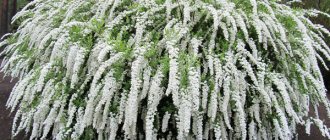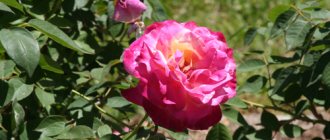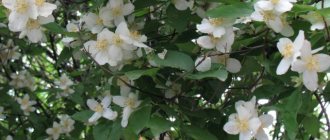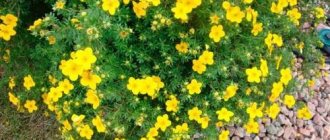Description of Nepalese cinquefoil
Cinquefoil Nepali grows naturally in Nepal and the Western Himalayas. The shrub reaches a height of about 50 cm. The leaves of the plant are large, palmate, and similar in appearance to strawberry leaves.
Cinquefoil can decorate any flowerbed
The inflorescences of the cinquefoil are paniculate and consist of small pink flowers. The plant blooms in the second year after planting. The flowering period lasts 2-2.5 months.
Nepalese cinquefoil has become the basis for hybrid varieties:
- Floris;
- Miss Wilmont;
- Roxana;
- Legend;
- Fiery flame.
Advantages of garden cinquefoil
This plant actually came to us from Nepal (and from the Western Himalayas in general). This explains the fact that cinquefoil is a heat-loving plant, but at the same time winter-hardy.
This herbaceous perennial grows a maximum of half a meter in height. Its large leaves resemble a paw (hence the name), and they can also be easily confused with our strawberries. In the photo on the Internet you can see cinquefoil with dark and bright green, even light green leaves. It is curious that all this can be the same plant variety - the fact is that the shade of the leaf blades is so curiously influenced by the soil on which the flower grew.
The plant blooms for about 2 months. The flower size is relatively small - up to 3 cm in diameter. Each flower consists of five rounded petals.
What is different about the Miss Wilmont variety?
- Flower color: they are bright, noticeably pink. The eye (middle) is similar in color to the petals, but much darker than them.
- The height of the stem is 50 cm, standard for the species. The purple stem quickly becomes overgrown with a large number of straight branches painted in the same shade.
- You need to buy and plant the seeds of this crop from March to April. This can be done either by seedlings or by sending the seeds directly into open ground.
Features of planting
Cinquefoil Abbotswood - description and care
The plant is completely undemanding to growing conditions. When growing a crop for good development and abundant flowering, you need to choose a suitable place.
For Nepalese cinquefoil, it is better to choose an open, well-lit area. Planting in partial shade is acceptable, but the lack of sunlight will certainly affect the appearance of the plant, especially the quality of its flowering.
Potentilla has small, richly colored flowers
The process of planting Nepalese cinquefoil is as follows:
- Dig a planting hole about 50-60 cm deep.
- Drainage material must be added to the bottom. It can be gravel, coarse sand, brick chips.
- The next layer is a mixture of soil, humus and sand.
- A seedling is planted and covered with soil.
- Water the planted plant. It must also be carried out within 2-3 weeks after planting, preventing the soil from drying out.
It is important to know! Nepalese cinquefoil prefers loose soils with a high lime content. The best option is loam or sandy loam.
Planting from seeds
Propagating cinquefoil by seed gives good results. Seed material is sown either for seedlings or immediately in a permanent place of growth. To plant seedlings, small seeds are carefully placed in a prepared substrate, covered with film or glass, placed in a warm place and periodically moistened. It is recommended to plant at the end of winter - at the beginning of spring.
Planting seedlings in open ground
When the young plants are strong enough, they are planted in a flower bed. It is advisable to do this, as well as plant seeds in open ground, no earlier than the end of spring, when the ground has warmed up and the threat of night frosts has passed.
The plant blooms from early summer until the first frost
Types and varieties of cinquefoil
There are a huge number of types and varieties of cinquefoil. More popular types and varieties will be described in more detail below.
Cinquefoil (Potentilla apennina) is a perennial plant with pubescent leaves of a trifoliate shape and a silvery hue. The flowers are pink or white.
White cinquefoil (Potentilla alba) is a perennial plant that grows up to twenty centimeters in height. The basal leaves are palmate-lobed. The flowers are white, collected in umbellate or racemose inflorescences.
Potentilla anserina (Potentilla anserina) - leaves are pinnately compound, yellow flowers up to 2 cm in diameter.
Nepalese cinquefoil (Potentilla nepalensis) is a perennial that can grow up to 50 cm. The stems are straight and branched, have a purple tint. The leaves are palmate-lobed and dark green in color. The flowers are quite large, red or pale pink. Flowering begins in July and lasts for 2 months.
The most popular varieties of this species: Roxana, Floris, Miss Wilmott.
Cinquefoil erecta, or straight, or galangal (Potentilla erecta) is a perennial that can grow up to 20 cm. The stem is erect and branched. The leaves are trifoliate. Single flowers. Flowering begins in July and lasts until autumn.
Silver cinquefoil (Potentilla argentea) is a perennial plant with arched stems. Grows up to 30 cm. The leaves are scaly and five-separated, covered with white hairs on the back side. The flowers are collected in thyroid-paniculate inflorescences. Flowering lasts from June to July.
Hybrid cinquefoil (Potentilla x hybrida) - this species includes many garden hybrid forms of the plant. The stems are straight and highly branched at the top. They grow up to 1 m in height. The leaves are trifoliate or serrate in shape. Velvety flowers of red, yellow, purple or pink
The most popular varieties: Master Floris, Vulcan, Yellow Queen.
How to care for Nepalese cinquefoil
Cinquefoil Goldfinger - description, planting and care
For good development and long flowering when caring for Nepalese cinquefoil, you must adhere to the following basic conditions:
- Watering. Mature plants do not need constant watering. In dry times, it is enough to keep the soil slightly moist. Mulching the soil can help with this. When watering, it is better to use heated water, since the roots of the plant are sensitive to temperature changes.
- Feeding. The plant needs feeding three times per season: in early spring, during the formation of buds and at the end of summer. It is advisable to use a complex mineral fertilizer with a predominance of nitrogen (at the beginning of the season) and potassium with phosphorus during subsequent procedures.
- Loosening. You need to make sure that there are no weeds growing in the flowerbed where the cinquefoil grows. To do this, they are regularly weeded, and the soil around the plants is loosened shallowly. This procedure helps saturate the soil with oxygen.
- Trimming. Nepalese cinquefoil bushes are prone to overgrowth, so periodically they need to undergo formative pruning. You can give the plantings any shape. Anti-aging pruning is carried out once every 4-5 years - in the spring the plant is cut off completely and be sure to fertilize it. Over the next season it rejuvenates.
Potentilla seeds give good germination
Useful tips for caring for flowers
If a person knows when and how to plant Nepalese cinquefoil, that’s good. But this is not enough. The shrub will delight you with its beauty if it receives proper care.
Watering
Regarding young seedlings, there are no questions about watering. An adult crop needs to moisten the soil every 2 weeks. There should be no stagnation of water on the ground. Cold water is also excluded, as it will destroy the roots of the plant.
Top dressing
The application of organic or mineral fertilizers is carried out if the land has been depleted. The procedure is carried out in the last days of summer.
Trimming
During the flowering period, the shrub is regularly cleaned of leaves and inflorescences that have dried out. This procedure prolongs the flowering period. To prevent the bush from losing its decorative appearance, it should be cut. It is held no more than 2 times per season.
Medicinal properties and contraindications of periwinkle, use and benefits of the flowerRead
Anti-aging pruning is carried out every five years. This is done in the spring, before the bush has time to wake up from winter hibernation. The stems are cut to the base.
Reproduction methods
Why cinquefoil does not bloom - what to feed
Nepalese cinquefoil is an unpretentious plant in terms of care and propagation. There are several ways to grow it on your plot or dacha:
- Growing from seeds. It is quite possible to prepare the seed material yourself. Ripe seeds are collected in late summer - early autumn. They can be planted immediately as seedlings or stored in a dry place until spring. Seed germination lasts 2.5-3 years.
- Using cuttings. At the beginning of summer, healthy, strong shoots are cut from last year's stems and the lower leaves are removed from them. Some of the resulting seedlings are treated with a solution to stimulate root growth and planted in pots with substrate. To quickly root, it is better for the plant to create greenhouse conditions by covering it with film, a jar or a plastic bottle. Periodically, the seedling needs to be irrigated. After it takes root and strengthens, you can plant it in open ground as an independent plant.
- By division method. This method is suitable for plants that are at least 4 years old. In spring or autumn, in warm weather, a healthy shoot is selected, carefully separated from the mother bush and planted as an independent plant.
- By layering. This method is used most often because it is the easiest to perform. The cinquefoil shoot is cut, bent to the ground and secured with a special pin. Near the cut, the shoot is sprinkled with soil. After the buried shoot forms a normal root system, it can be disconnected from the parent plant and planted separately.
Aftercare (watering, fertilizing, loosening, mulching, pruning, preparing for winter)
If the weather is dry and hot, the cinquefoil needs watering 2-3 times a week. For 1 sq. per meter of planting consumes about 10 liters of water.
In rainy and cloudy weather, watering plants should be limited, since the root system of flowers may suffer from excessive moisture.
Three times during the entire growing season, cinquefoil can be fed with organic fertilizers. It is very good to add ash solution to them. It is better to time fertilizing to coincide with the following phases of plant development:
- in early spring, immediately after the main snow cover melts;
- approximately in mid-May, at the time of the formation of the first buds on the plant;
- after flowering - in August or September.
Instead of loosening the soil and removing weeds under the cinquefoil, it is more advisable to use mulching with any organic matter: hay, straw, rotted sawdust. This can be done both in the spring and throughout the growing season.
Only wilted, dried out and diseased shoots of plants are pruned. Regular removal of faded flowers promotes longer flowering.
The Nepalese cinquefoil flower tolerates almost any frost well. Bushes should be protected only in regions where in winter there are simultaneously frosts above -25 °C and thaws to zero or above. In this case, a good layer of mulch or pine spruce branches can help.
Possible diseases and pests
In general, the crop exhibits good resistance to diseases and pests. And cases of plant damage by certain diseases are a consequence of violation of the rules of caring for it.
The development of rust in cinquefoil is associated with excess moisture in the soil. When it appears, the plant will have to be treated with Bordeaux mixture or fungicides.
Among the pests, the cutworm, which feeds on flowers and leaves, is most capable of annoying the cinquefoil. Lack of timely treatment can lead to the death of the plant. To get rid of the cutworm, the bushes need to be treated twice with an insecticide solution.
Cinquefoil is widely used in folk medicine
Use in landscape design
Cinquefoil Miss Wilmont is used by modern landscape designers in both single and group plantings. Single plants are most often represented by plantings near borders, on empty ground under tall bushes with bare stems.
Complex compositions of cinquefoil with lupins, cornflowers, as well as plants that are distinguished by inexpressive flowering also look impressive in flower beds. The Legend cinquefoil is often found on alpine hills and among stones.
Cinquefoil Miss Willmott - one of the most colorful hybrids
Popular varieties
Since Nepalese cinquefoil has been used in gardening since the beginning of the 19th century, quite a few hybrid varieties have already been bred. The main differences between individual varieties are not in the care process, but in the appearance (color of the buds) and the time when the bush blooms.
"Miss Wilmont" is considered one of the most popular varieties of Nepalese cinquefoil. Beautiful flowers are painted in the deep color of ripe cherry. In the middle of each there is a darkened roundness. This variety pleases gardeners with open buds much larger and more abundant than others. It requires serious care and can easily withstand winter temperatures.
The “Legend” variety has a darkened center and pink petals, the shade of which becomes darker over time. Just like other representatives of the Nepalese cinquefoil, this variety is grown very simply. The “Fire Flame” variety is especially valued for its unusual color. The center of the open bud is painted in a mixture of crimson and red, and the petals have a delicate tone, which is a mixture of vanilla and pink. This variety blooms in July and continues to bloom almost until September. The height of the bush is only 40 centimeters.
The Ron Mac Bees variety has a star-shaped center and a color reminiscent of Miss Wilmont. The shrub reaches a height of barely 30 centimeters, and its long flowering lasts from May to September. The flowers of the “Flower Carpet” variety are painted in an exotic coral color. Flowering lasts from the second half of June until mid-September. This variety feels great on any soil, but requires high-quality lighting. The Floris variety looks similar, but is characterized by the presence of a bright orange center.
Beneficial features
Due to the rich content of essential oils and vitamin C, the plant is used in folk medicine, especially for colds.
Cinquefoil Nepali, which is a shrubby perennial plant, is often used for growing at home in the garden. She will need a well-lit place and feeding at the end of the season. In return, the plant will reward you with long-term flowering of abundant flowers of bright colors. Nepalese cinquefoil Miss Wilmont looks especially elegant.
Due to its healing properties, the plant is used in folk medicine for various diseases, especially colds. And even an inexperienced gardener can grow cinquefoil.











